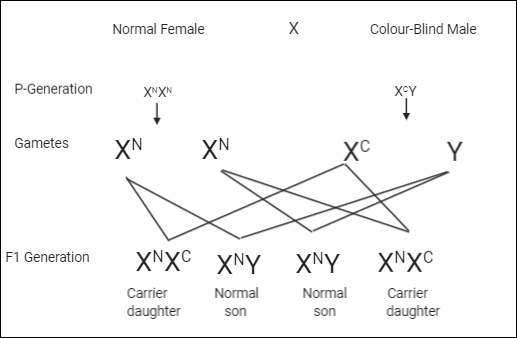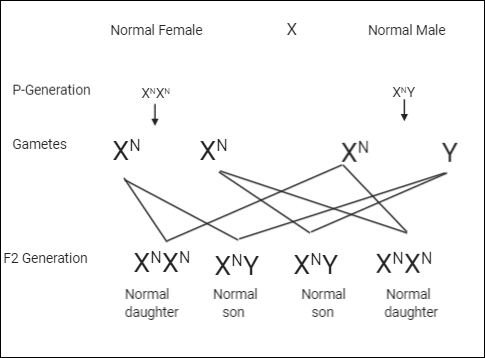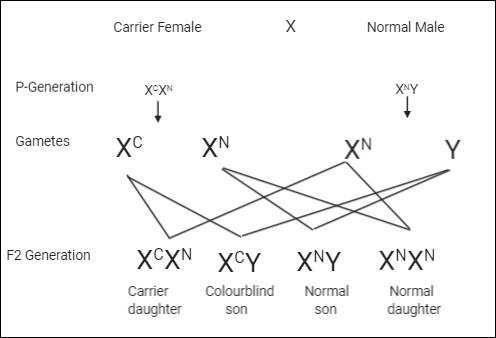Answer
396.9k+ views
Hint:Color blindness is a genetic disorder associated with the X chromosome. In this, a person is unable to identify certain colors. Mostly they cannot distinguish between green and red, and rarely blue.
Complete answer:Genetic disorders are diseases caused due to incorrect alteration in either the whole genome or a part of DNA sequence and they are hierarchical i.e. they are passed from parents to offspring. Some of the examples of genetic disorders are Down syndrome, cystic fibrosis, sickle cell anemia, hemophilia, etc.
Color blindness is also an example of a genetic disorder. In this the gene responsible for color blindness is located on the X-chromosome hence it is also known as X-linked inheritance. This person cannot identify the colors. It is also called an X-linked recessive disorder because the gene for color blindness present on the X chromosome always causes expression of phenotype in male progeny and in females only if she is homozygous. To understand this let’s consider,
${{\text{X}}^{\text{C}}}$= Defective allele for color blindness
${{\text{X}}^{\text{N}}}$= Normal allele for color blindness
If a cross is done between a color-blind man and a woman with normal sight who has no history of color blindness in her family then, in the F1 generation the progenies will be two normal males with and two carrier daughters.

Now in the F2 generation, if a cross is done between the normal male from the F1 generation with a normal female then will have all normal progeny i.e. two normal sons and two normal daughters

If we cross the carrier female from the first generation with a normal male then the progeny would have one normal male and one color blind male whereas one carrier daughter and one normal daughter.

Hence, the probability of a grandson of a color-blind man and woman with normal sight being color blind will be 0.25 as from F2 generation out of 4 sons only one is color blind.
Hence, the correct option is option A-0.25.
Note: Color blindness is referred to as red-green color blindness because our retina contains cone cells that perceive colors and can absorb different wavelengths with the help of pigments called Opsins also called photo opsins. Opsins are of three types based on the type of wavelength absorption. S-type: absorb small wavelength (blue-sensitive opsin); M-type: absorb medium wavelength (green-sensitive opsin); L-type: absorb Large wavelength (red-sensitive opsin). Gene encoding S-type opsin is found on chromosome number 7 whereas M-type and L-type are found exclusively on X-chromosome.
Complete answer:Genetic disorders are diseases caused due to incorrect alteration in either the whole genome or a part of DNA sequence and they are hierarchical i.e. they are passed from parents to offspring. Some of the examples of genetic disorders are Down syndrome, cystic fibrosis, sickle cell anemia, hemophilia, etc.
Color blindness is also an example of a genetic disorder. In this the gene responsible for color blindness is located on the X-chromosome hence it is also known as X-linked inheritance. This person cannot identify the colors. It is also called an X-linked recessive disorder because the gene for color blindness present on the X chromosome always causes expression of phenotype in male progeny and in females only if she is homozygous. To understand this let’s consider,
${{\text{X}}^{\text{C}}}$= Defective allele for color blindness
${{\text{X}}^{\text{N}}}$= Normal allele for color blindness
If a cross is done between a color-blind man and a woman with normal sight who has no history of color blindness in her family then, in the F1 generation the progenies will be two normal males with and two carrier daughters.

Now in the F2 generation, if a cross is done between the normal male from the F1 generation with a normal female then will have all normal progeny i.e. two normal sons and two normal daughters

If we cross the carrier female from the first generation with a normal male then the progeny would have one normal male and one color blind male whereas one carrier daughter and one normal daughter.

Hence, the probability of a grandson of a color-blind man and woman with normal sight being color blind will be 0.25 as from F2 generation out of 4 sons only one is color blind.
Hence, the correct option is option A-0.25.
Note: Color blindness is referred to as red-green color blindness because our retina contains cone cells that perceive colors and can absorb different wavelengths with the help of pigments called Opsins also called photo opsins. Opsins are of three types based on the type of wavelength absorption. S-type: absorb small wavelength (blue-sensitive opsin); M-type: absorb medium wavelength (green-sensitive opsin); L-type: absorb Large wavelength (red-sensitive opsin). Gene encoding S-type opsin is found on chromosome number 7 whereas M-type and L-type are found exclusively on X-chromosome.
Recently Updated Pages
How many sigma and pi bonds are present in HCequiv class 11 chemistry CBSE

Why Are Noble Gases NonReactive class 11 chemistry CBSE

Let X and Y be the sets of all positive divisors of class 11 maths CBSE

Let x and y be 2 real numbers which satisfy the equations class 11 maths CBSE

Let x 4log 2sqrt 9k 1 + 7 and y dfrac132log 2sqrt5 class 11 maths CBSE

Let x22ax+b20 and x22bx+a20 be two equations Then the class 11 maths CBSE

Trending doubts
Fill the blanks with the suitable prepositions 1 The class 9 english CBSE

At which age domestication of animals started A Neolithic class 11 social science CBSE

Which are the Top 10 Largest Countries of the World?

Give 10 examples for herbs , shrubs , climbers , creepers

Difference between Prokaryotic cell and Eukaryotic class 11 biology CBSE

Difference Between Plant Cell and Animal Cell

Write a letter to the principal requesting him to grant class 10 english CBSE

Change the following sentences into negative and interrogative class 10 english CBSE

Fill in the blanks A 1 lakh ten thousand B 1 million class 9 maths CBSE



